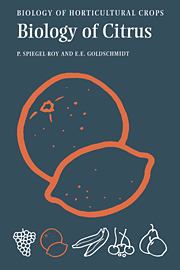5 - Aspects of cultivated citrus
Published online by Cambridge University Press: 27 October 2009
Summary
Orchard design and spacing
With careful adjustment of rootstocks and cultural practices citrus can be grown satisfactorily on a wide range of soils. In general, the deep, well-drained sandy loam soils are best suited for citrus production. No single characteristic of good citrus soil is more essential than good drainage. Without satisfactory drainage, accumulation of free water in the root zone results in poor aeration and injury to roots. In regions of heavy rainfall, the use of shallow soils with impervious subsoils or with hardpan is particularly hazardous, because under such conditions roots are most susceptible to fungal infection. Lack of drainage also contributes to effects caused by salinity which, in turn, may reduce yields. As salinity of irrigation water increases, it is necessary to move more water through the root zone to carry out accumulated salts. Thus, any restriction of drainage becomes especially harmful where irrigation is practiced.
In detailed planning of the orchard, decisions regarding planting distances and tree spacing are most important. For many years, considerations have centered on the distance which would optimize yields during the entire life of the orchard (several decades), also allowing sufficient space to conduct necessary cultural operations. Trees have been planted at distances assuring adequate light for the tree and the passage of equipment at maturity. Thus, distances between trees (varying, of course, with variety, rootstock, etc.), have generally ranged 6 to 10.5 meters in either direction, resulting in tree densities of 86–270 trees per hectare in California, Florida and South Africa.
- Type
- Chapter
- Information
- The Biology of Citrus , pp. 126 - 184Publisher: Cambridge University PressPrint publication year: 1996



